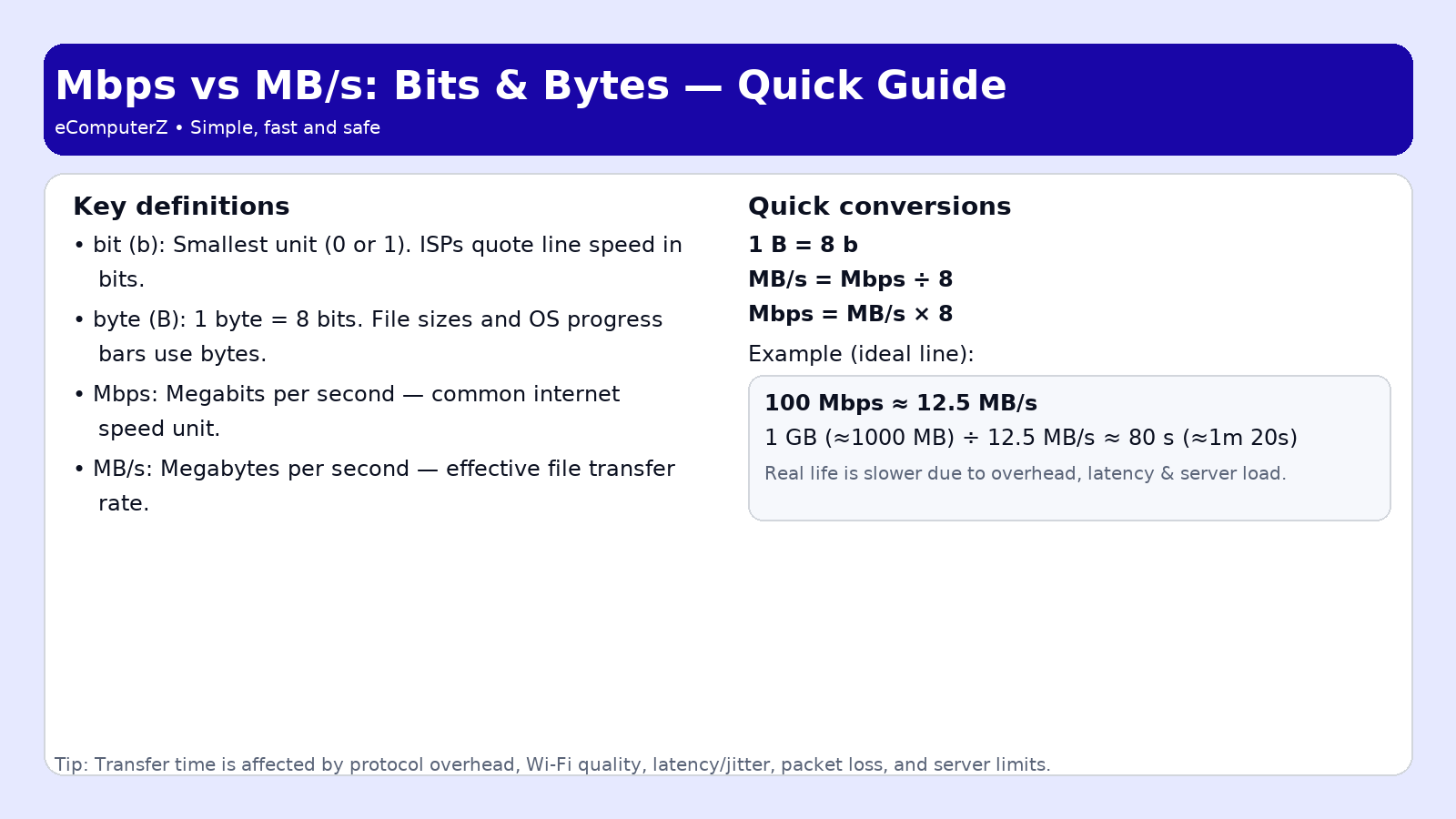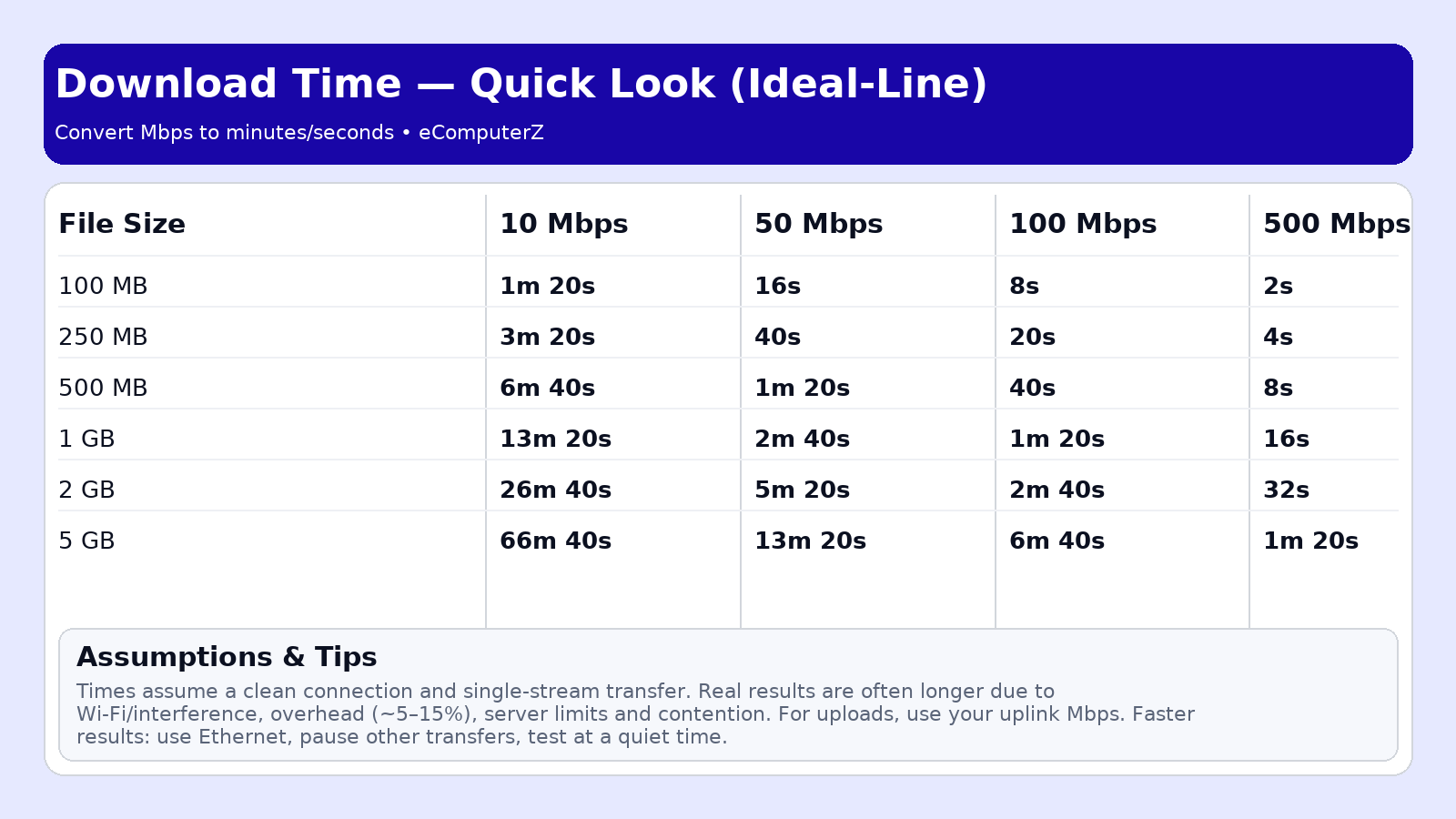Loading…
The File Speed Transfer Calculator
Use this file speed transfer calculator to convert file size and internet speed into realistic download or upload time. Enter your file size, pick Mbps or Gbps, and get a clear estimate in seconds, minutes, or hours. For best results, measure your real speed first and then return to this calculator.
How to Use The File Speed Transfer Calculator
- Choose your file size (MB, GB, or TB). The quick-pick chips help if you’re unsure.
- Enter your download speed (usually in Mbps from your ISP or speed test). Add upload speed if estimating uploads.
- Adjust “Efficiency” to account for protocol overhead. 90% is a good default; lower if your Wi-Fi is weak or the server is busy.
- Click “Estimate time.” You’ll get a compact, human-readable result (e.g., 2 min 5 secs).
Tip: If you leave upload speed blank, the tool uses your download speed as a fallback.
Download / Upload Time Estimator
Quickly estimate how long transfers will take at your connection speed. How accurate is this?
Tip: Measure your connection first (optional)
For the most accurate estimate, first measure your real‑world connection with our
Internet Speed Test, then enter the measured download/upload speeds below.
Enter your details
Tip: Try quick picks below if you're not sure.
As advertised by your ISP (e.g., 50 Mbps, 1 Gbps).
Uploads are often slower than downloads. Enter your measured value if available. Tip: leave this blank to use your download speed.
Advanced options
Lower90%Higher
Rough estimate; actual results depend on your provider.
Estimated times
Enter size and speed, then select Estimate time.
Technical details (effective speeds)
Effective download speed
—
Effective upload speed
—
How we estimate: ISPs quote megabits per second (Mbps). Files are in bytes. We convert using
8 bits = 1 byte and apply an efficiency factor to allow for overhead. Real‑world times vary.
File Speed Transfer Calculator — FAQs
Why might my actual time differ from the estimate?
Real‑world speeds vary due to Wi‑Fi strength, network congestion, server throttling, and protocol overhead. The Efficiency slider lets you account for this (typical 85–95%).
Should I use Mbps or MB/s?
ISPs advertise megabits per second (Mbps). File sizes are in bytes. We convert using
8 bits = 1 byte. If your tool shows MB/s, multiply by 8 to get Mbps.Decimal vs Binary — which should I pick?
Most consumer tools use Decimal (1 MB = 1,000,000 bytes). Some OS/file utilities use Binary (1 MiB = 1,048,576 bytes). Pick the one that matches your source, or leave on Decimal.
What does the Efficiency slider change?
It models protocol overhead (TCP/IP, TLS, chunking, retries). Lower efficiency means more overhead → longer times. Start at 90% if unsure.
How do parallel uploads help?
Some services upload multiple files at once. This can improve throughput if your connection and the server allow it. Results vary, so we cap the effect for a realistic ballpark.
How do I get the most accurate numbers?
Run our Internet Speed Test, then enter the measured download and upload speeds. Prefer wired/Ethernet during testing, pause other downloads, and keep the browser tab in focus.
Infographics | Understanding Mbps V MB/s & Download Times
 Explainer showing the difference between Mbps and MB/s with a 100 Mbps example and quick conversions
Explainer showing the difference between Mbps and MB/s with a 100 Mbps example and quick conversions Quick-look table of download times for 100 MB–5 GB files at 10/50/100/500 Mbps, with notes on real-world factors
Quick-look table of download times for 100 MB–5 GB files at 10/50/100/500 Mbps, with notes on real-world factorsFile Speed Transfer Calculator | References and Further Reading
Core concepts
- NIST: Bits, Bytes & Binary Prefixes (kilo vs kibi) Clear definitions for kbit/MB vs Kibit/MiB to avoid size/speed confusion.
- Ookla Glossary: Mbps vs MB/s Quick refresher on internet speed units used by most tests and ISPs.
- Cloudflare Learning: Latency, Bandwidth & Throughput How these metrics differ and why real-world throughput can be lower than line rate.
UK guidance & performance
- Ofcom: Practical tips to improve your broadband speed Router placement, interference, testing your line and talking to your ISP.
- Ofcom: Broadband speeds — what you need to know Speed estimates, guarantees and what to do if you get less than promised.
- Ofcom: Your right to request a “decent” broadband connection USO: at least 10 Mbit/s down & 1 Mbit/s up, eligibility and how to apply.
- Ofcom: UK Home Broadband Performance (report PDF) Real-world performance snapshots across ADSL, FTTC, cable and full-fibre.
Measuring & interpreting speed tests
- Cloudflare: How the Speed Test works (idle vs loaded latency) Explains why “bufferbloat” and congestion affect results and your experience. Updated 2025
- Cloudflare Radar: Internet Quality metrics Latency, jitter and loss trends by country and network—useful context for results.
- Ookla: How much speed do you really need? Rules of thumb for common activities (4K streaming, video calls, gaming, etc.).
For US readers
- FCC: Broadband Speed Guide Minimum speeds suggested for popular online activities.
- FCC (Mar 2024): New broadband benchmark (100/20 Mbps) Context for “fast enough” when comparing plans and test results.
- FCC: Using the National Broadband Map Check available technologies and advertised speeds at your address.
Advanced (why estimates differ)
- Cloudflare: Testing home network performance (jitter explained) Why consistent latency (low jitter) matters for calls and gaming.
- ThousandEyes: Simple model for TCP throughput How loss, RTT and window sizes cap file-transfer speeds even on fast lines.
- APNIC Labs: BBR TCP & congestion control Modern congestion control can change your real-world throughput dynamics.
Tip: Real-world transfer time depends on network quality (latency, jitter, loss), protocol overhead, server load and parallel connections—not just raw Mbps.
Was this page helpful?
Thanks! ✅